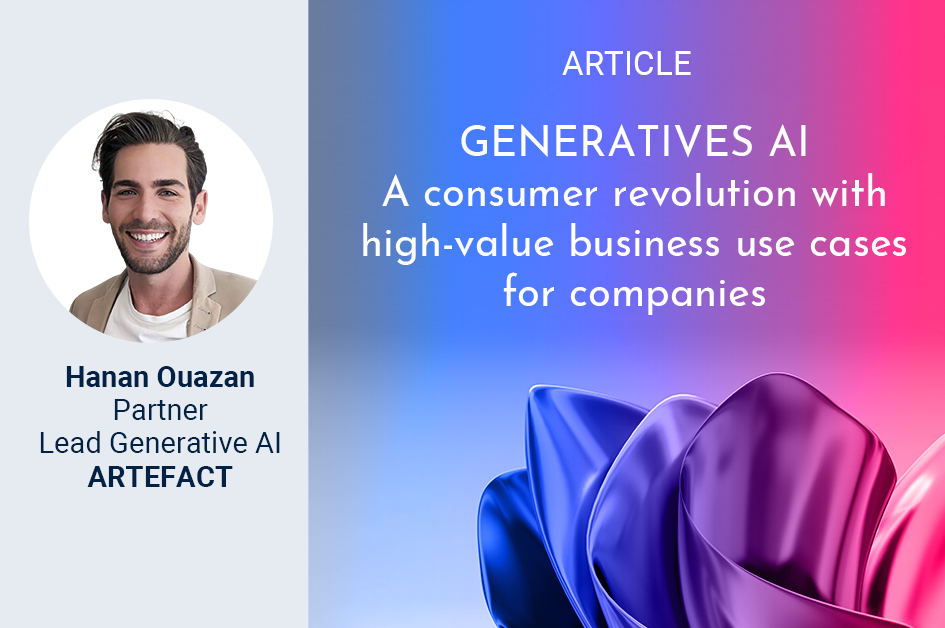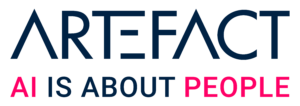Since late 2022, the field of generative Artificial Intelligence has been booming. This new dynamism in the sector means that most major brands supported by Artefact are now considering integrating these technologies into their business applications, to win the race for efficiency and adoption by their customers and employees. Their levels of maturity on the subject, however, are varied: few companies have launched use cases (60% have initiated projects, some 26% have launched POCs), and only 3% have yet industrialized them. How will generative AI technologies create significant and immediate business impact for companies?
Figures – June 2023
A technological shift accelerating AI use by businesses
For the past six months, generative Artifical Intelligence players have been running a marathon, continuously announcing major advances in the field. From Web giants such as Microsoft with Open AI, Google with PaLM, Amazon with Bedrock and Meta with LLama, to open source developers, many generative AI actors offer technologies that drive innovation in business applications. For example, GPT integrates the Bing search engine and Microsoft’s office suite, while all Google products will benefit from PaLM 2. Amazon and Meta are beginning to integrate their generative AI into their advertising products. And the recent emergence of hundreds of open source solutions makes it easier for developers from all backgrounds to access this type of technology.
Not all players are adopting the same strategic approach. Some, like Open AI, focus on the ultra-performance of their model, while other players like Google are also developing lighter – but effective – versions of their algorithms. These versions are more efficient for local integration on users’ devices (mobile, desktop, connected speakers) as well as in specialized “business” software.
This dynamic ecosystem encourages the use of generative AI in both B2C and B2B markets. For companies, it represents new opportunities to maximize their performance, as well as that of their employees and customers. According to a recent Goldman Sachs report, this technology could boost US labor productivity and GDP by 7% over the next ten years.
Four categories of applications based on generative AI to “augment” business operations
The use of generative Artifical Intelligence across the entire business value chain is not new, but its use is now democratized and multiplied. For some major brands and the AI services companies that support them, use cases are already being designed and deployed at the test stage.
Although the possibilities are limitless, and applications depend on business needs, these main uses can be divided into four categories.
The first concerns accessibility to previously complex data for roles with little or no data analysis expertise. AI capabilities enable the development of intuitive tools so that business users can access, consult and sort very large volumes of data, obtaining dashboards and new data in a matter of seconds. Recent advances in natural language processing (NLP) make it even easier for these professions to interact with data. Specialized software in fields such as finance, marketing or logistics can thus be “augmented” via generative functionalities that automate repetitive and/or time-consuming tasks to assist these roles in their decision-making. Artefact enabled the sales teams of a service company to rely on a lead qualification solution that pinpoints the intentions of customers and prospects by detecting signals within very large volumes of data. International retailers can also better manage inventories and optimize pricing policies by cross-referencing numerous parameters to better understand the causes of sales increases or decreases for a given product or category.
The second concerns the company’s relationship with its various audiences. We’re working with a number of brands to create chatbots and call centers powered by generative AI to respond to customer requests in a more relevant and highly personalized way, during interactions that resemble a conversation between two humans. Insights can also be gleaned from these exchanges to better understand the needs and expectations of the brand’s callers, boosting customer satisfaction.
The third category, already widely used today, is content generation. It’s a fast-growing application for developing and adapting texts, images and sounds to feed companies’ marketing activities: site content, product sheets, mailings, advertising, presentations, etc. For example, we’re working on a “content supercharger” project for an automotive group. This solution leverages the manufacturer’s proprietary data and capitalizes on advanced social network monitoring to boost the production of personalized content for the brand. Creative professionals can now free themselves from time-consuming tasks, such as adapting concepts, and focus on their added value: ideation and strategy.
The fourth major application is improving the efficiency of pre-existing models or logistics processes. For example, companies in the bancassurance sector generally have several algorithms dedicated to risk prediction or fraud detection. These tools may not have the same interpretation of the various signals they pick up. In such situations, human agents should be able to make decisions quickly and easily. This is where a layer of generative AI can be added to summarize – in a digestible manner for a human – the reasons that led the initial algorithms to present their conclusions.
A groundswell disrupting the economy and organizations
We’re at the very beginning of a revolution in usage, not only in everyday life, but also in business applications. Generative Artifical Intelligence is so intuitive and easy to use that it will soon be deployed in companies, to avoid creating too great a gap between the fluidity of personal and professional uses.
The entire business value chain will be impacted, and while we’re still in the early stages, the first integrations are already very promising. To make the most of them today and prepare for the future, brands will need to rapidly gain maturity on the subject. To meet the technical, environmental and ethical challenges posed by AI, they’ll need to recruit new functions and acculturate employees, choose the right AI-generating technologies, set up appropriate governance, identify use cases with business units, and ensure the transparency, ethics and environmental impact of the applications developed.

 BLOG
BLOG




